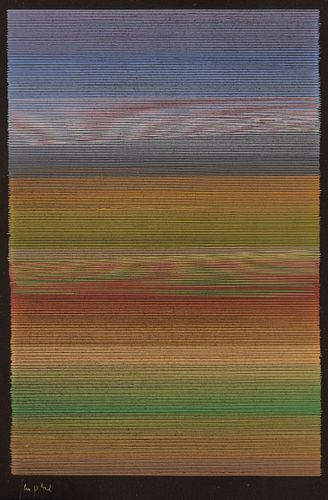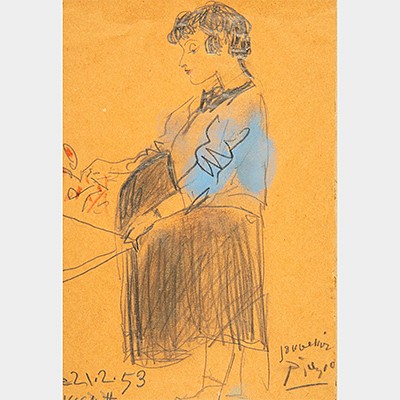EUSEBIO SEMPERE (Onil, Alicante, 1923 - 1985). "Landscape", circa 1977. Gouache on cardboard. Work reproduced in the Catalogue of the exhibition XIII.
Lot 102
About Seller
Setdart Auction House
Carrer Aragó 346
Barcelona
Spain
Setdart Subastas was born in 2004 and is currently the first online art auction in Spain with solidity, prestige and reliability guaranteed by our more than 60,000 users. Setdart has a young, dynamic and enterprising team ready to successfully manage the purchase and sale of art works through custom...Read more
Categories
Estimate:
EUR€5,000 - EUR€6,000
$5,376.34 - $6,451.61
Absentee vs Live bid
Two ways to bid:
- Leave a max absentee bid and the platform will bid on your behalf up to your maximum bid during the live auction.
- Bid live during the auction and your bids will be submitted real-time to the auctioneer.
Bid Increments
| Price | Bid Increment |
|---|---|
| EUR€0 | EUR€10 |
| EUR€200 | EUR€25 |
| EUR€500 | EUR€50 |
| EUR€1,000 | EUR€100 |
| EUR€3,000 | EUR€200 |
| EUR€5,000 | EUR€500 |
| EUR€10,000 | EUR€1,000 |
| EUR€20,000 | EUR€2,000 |
| EUR€50,000 | EUR€5,000 |
About Auction
By Setdart Auction House
Sep 20, 2021
Set Reminder
2021-09-20 08:00:00
2021-09-20 08:00:00
America/New_York
Bidsquare
Bidsquare : CONTEMPORARY ART
https://www.bidsquare.com/auctions/setdart-auction-house/contemporary-art-7482
Setdart Auction House sofia@setdart.com
Setdart Auction House sofia@setdart.com
- Lot Description
EUSEBIO SEMPERE (Onil, Alicante, 1923 - 1985). "Landscape", circa 1977. Gouache on cardboard. Work reproduced in the Catalogue of the exhibition XIII. Benlliure Gallery (Valencia, 1999). Signed in the lower left corner. Size: 26.5 x 19 cm; 48 x 28 cm (cardboard); 60 x 51 cm (frame). Through a vertical format, Sempere traces a classically inspired landscape, conceived or through a high horizon, where the tonalities that make up the earth are superimposed until reaching a sky in which a chromatic range of cold colours predominates. Reinterpreting the pictorial tradition of the landscape, the author uses a language created through the use of parallel lines, which have been drawn with a drawing pen. The result is a geometric whole in which he plays with transparency, rhythm and depth. It was from the 1960s onwards, when Sempere settled definitively in Spain, that he introduced a certain evocative sense into his works, as can be seen in this work. A piece composed through chromaticism, a concept Sempere worked with throughout his career, as can be seen in his set of four works "The Seasons", which belong to the collection of the Fundación Juan March. Sculptor, painter and graphic artist, Sempere is the most representative painter of kinetic art in Spain. He began his studies at the School of Arts and Crafts in Valencia, and in 1941 he entered the San Carlos School of Fine Arts in the same city. In 1948 he obtained a grant from the SEU which enabled him to travel to Paris, and the following year he settled in the French capital, at the Colegio de España in the Cité Universitaire. That same year, 1949, he organised the First Exhibition of Abstract Art in Valencia, in the Mateu Gallery. In 1953 he produces his first gouaches on paper, and in 1955 he writes the "Manifiesto de la Luz" (Manifesto of Light) and undertakes his first Relieves Luminosos (Luminous Reliefs). At this time he began to learn a silk-screen printing technique unknown in Spain, and made silk-screen prints for Vasarely, Mortensen and Bloc, among others. In 1960 he returned to Spain and settled in Madrid, showing his Relieves Luminosos (Luminous Reliefs) at the Venice Biennale that same year. Also in 1960 he made the definitive international leap, exhibiting his work at the Berta Schaefer Gallery in New York. In 1961 he held his first solo exhibition at the Ateneo de Madrid, and in 1962 he began to create the Rejas, two-piece iron mobiles. The following year he obtained the Ford grant to travel to the United States, where he moved in 1964. That same year he exhibited again at the Berta Schaefer gallery, together with J. M. Subirachs. In the following years he produces his first portfolio of silkscreen prints, a musical mobile sculpture project for IBM and a project for the Parque de Esculturas de La Castellana, in Madrid. In 1969 he took part in the seminar on Analysis and Automatic Generation of Plastic Forms at the Calculus Centre of the University of Madrid. Ten years later his hanging sculpture "Helicoidal" was offered as a gift to the Congress of Europe by President Adolfo Suárez, and in 1980 the first anthological exhibition dedicated to his work was held. That same year he was awarded the Gold Medal for Merit in the Fine Arts. At the beginning of the 1980s his health began to deteriorate seriously, although he continued to work. In 1983 he was awarded the Prince of Asturias Prize for Fine Arts, and was named favourite son of the province by the Provincial Council of Alicante.
- Shipping Info
-
In-house shipping available. Please inquire at admin@setdart.com.
-
- Buyer's Premium



 EUR
EUR CAD
CAD AUD
AUD GBP
GBP MXN
MXN HKD
HKD CNY
CNY MYR
MYR SEK
SEK SGD
SGD CHF
CHF THB
THB















